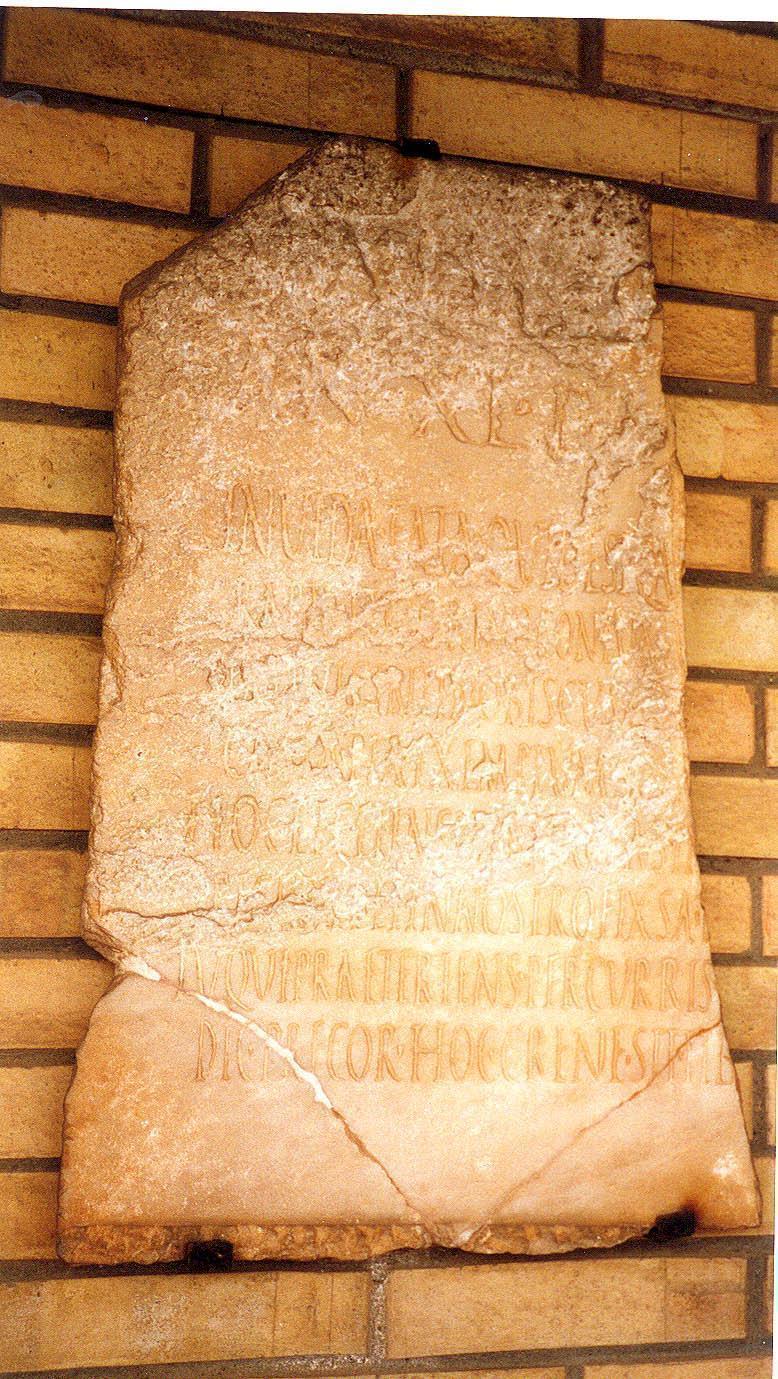Epitaph of Valeria Crene
Reference CIL II2/ 5, 1074 | Description | Lyrics | Location | Chronology | Epigraphic edition | Translation | Apparatus | Comentary | Type of verse | Text divided into verses and metric signs | Images | Bibliography | Link to DB | Author |
Epitaph of Valeria Crene
Description
- Idno filename 22/01/0090
- Type of inscription: Sepulcralis
- Support: Tablet
- Material: Marble Material Description: White color.
- Conservation status: Broken into three pieces. The right-hand side is missing (20-25). Surface rough and eroded. Upper left corner broken without affecting text.
- Dimensions height/width/depth (cm): 64/43.5/2.5
-
Epigraphic field:
- Layout: Triangular interpunction. Remains of guidelines in the verse part.
- Epigraphic field execution: Polished epigraphical field.
- Corpus: II/2 5, 1074
- Preserved
Lyrics
- Font:Book capital
- Letter size:5-3 cm
- Description of the letters:Letters decreasing. Carefully executed book script (square in the first two lines); deep cut. The arms of the <F> are oblique. The <P> and the <R> do not have closed lobes. <T> with upper right stroke curved. <X> with upper right stroke curved upwards.
Location
- Place of discovery: From Osuna (Vrso)
- Geolocation
- Conservation location: conserved in Málaga, in the house of writers Mª Victoria Atencia and Rafael León(†).
- Location with Modern Nomenclature España / Málaga
- Location with Old Nomenclature Hispania / Baetica / Astigitanus / Malaca
Chronology
- Inscription's dating: Between year 100 and year 199
- Dating explanation: From the paleography.
Type of verse
- Type of verse: Elegiac couplet
- Verse/line correspondence: Si
- Prose/verse distinction: No
Epigraphic edition
Valeria [- l(iberta)? Crene]
an(norum) ▴ XL ▴ p(ia) ▴ i(n) ▴ [s(uis) ▴ h(ic) ▴ s(ita) ▴ e(st)]
invida ▴ fata ▴ quid est qu[od Crene nostra recessit?]
rapta ▴ peregrino contumu[lata] [solo/loco?]
5 sex et viginti ▴ nobiscum▴ de[gerat annos]
casta ▴ pia ▴ exemplum ▴ sola [dedit?] ▴
hoc ▴ licet ▴ in saxso (!) iaceas ▴ in [saecula longa] aut [tempora longa]
pectore ▴et ▴ in ▴ nostro fixsa (!) ▴ t[eneris item]
tu qui praeteriens ▴ percurris ▴ [‑ ‑ ‑]
10 dic ▴ precor ▴ hoc ▴ Crene ▴ sit ▴ tib[i ▴ terra ▴ levis]
Text divided into verses and metric signs
Invida fata, quid est qu[od Crene nostra recessit]. lkk|lkk|l/[l|ll|lkk|l~]
Rapta peregrino contumu[ata solo/loco], lkk|ll|l||lkk|[lkk|~]
sex et viginti nobiscum de[gerat annos], ll|ll|l/l|ll|l[kk|l~]
casta, pia, exemplum sola [- – – dedit]. lkk|ll|l||lk[k|lkk|~]
5 hoc licet in saxso iaceas, in [saecula/tempora longa], lkk|l/l|l/kk|l/l|[lkk|l~]
pectore et in nostro fixsa t[eneris item]. lkk|ll|l||lk[k|lkk|~]
Tu qui praeteriens percurris [carmina cuncta / limina busti], ll|lkk|l/l|ll|[lkk|l~]
dic, precor, hoc: ‘Crene, sit tib[i terra levis’]. lkk|ll|l||lk[k|lkk|~]
Translation
Valeria (Crene), of forty years, loved (by her own is buried here). Cruel fate, what reason is there (for our beloved Crene to have died?). Snatched away, buried in foreign (soil), she had spent twenty-six years with us. Honourable and loving, she alone (gave us) an (undying) example. Although you are below this stone (for ever and ever), (we will equally hold you) deep in our hearts. You who pass by and observe ***, say this, I pray you: Crene, (may the earth rest lightly on you).
Bibliography
RECIO 1976, 95–99 cum im. phot.; ATENCIA 1978, 191–195, cum im. phot. et suppl. scripto a MARINER; GONZÁLEZ FERNÁNDEZ, CILA II, 657; id. II2/5, 1074; (inde HEp 2001, 461); FERNÁNDEZ MARTÍNEZ – CARANDE 2005 (CD), 693–700; id., CLEB, SE13, cum im. phot, quae in linguam Hispanicam verterunt (inde HEp 2005, 317); FERNÁNDEZ MARTÍNEZ 2010, 87-96, cum im. phot., quae in linguam Hispanicam vertit; CUGUSI 2012, 44.
Apparatus
1 Valeria [Crene] MARINER; Valeria [- l(iberta)? Crene] supp. GONZÁLEZ FERNÁNDEZ. – 3 qu[od Crene nostra recessit?] suppl. MARINER. – 4 contumu[lata solo] MARINER, fortasse loco nos (cf. infra). – 5 de[gerat annos] MARINER. – 6 sola [perenne dedit] MARINER. – 7 in [saecula cuncta] MARINER, fortasse [saecula longa] aut [tempora longa] nos (cf. infra). – 8 se et in nostro fixsa s… RECIO; fixsa [manebis item] MARINER; fixsa +[ ] GONZÁLEZ FERNÁNDEZ. – 9 percurris v[iam] RECIO; per¬curris [busta viator] MARINER, GONZÁLEZ FERNÁNDEZ, carmina hospes SCHMIDT in GONZÁLEZ FERNÁNDEZ; [carmina cuncta] aut [limina busti] nos (cf. infra).
Comentary
Author
- Author:C. Fernández Martínez, R. Carande Herrero
- Last Update2024-05-07 16:08:38
- Autopsy date:2001
You can download this






